Florida |
|
|
|
| Übersicht – Contents: | |
Florida |
|
|
|
| Übersicht – Contents: | |
Flagge – Flag: |
|
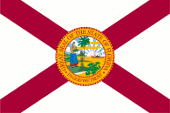 |
seit/since 1985, Staatsflagge – state flag, Seitenverhältnis – ratio 2:3, Quelle/Source, nach/by: Wikipedia (EN), 50states.com, Corel Draw 4   |
historische Flaggen – historical Flags: |
|
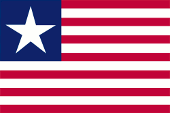 |
1861, Flagge von Florida – flag of Florida, Quelle/Source, nach/by: Flags of the World |
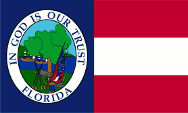 |
1861–1865, Flagge von Florida – flag of Florida, Seitenverhältnis – ratio 3:5 (?), Quelle/Source, nach/by: Flags of the World |
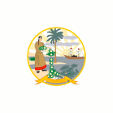 |
1868–1900, Flagge von Florida – flag of Florida, Seitenverhältnis – ratio 1:1, Quelle/Source, nach/by: Flags of the World, Corel Draw 4 |
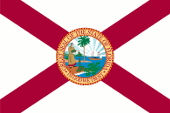 |
1900–1985, Staatsflagge – state flag, Seitenverhältnis – ratio 2:3, Quelle/Source, nach/by: Wikipedia (EN), Corel Draw 4 |
| Die heutige Flagge von Florida wurde im Jahre 1900 eingeführt, und am 21.05.1985 ein einigen Details im Siegel abgeändert. Sie zeigt ein weißes Flaggentuch mit einem roten Diagonalkreuz darin, und in der Mitte aufgelegt das Siegel des Landes. Das Siegel zeigt in einer Küstenlandschaft eine Sabalpalme, eine aufgehende goldene Sonne, ein Dampfschiff und am üppig bewachsenen Ufer eine eingeborene Frau vom Stamm der Seminolen, die Blumen streut. Die Flagge präsentiert Florida als das Land des Sonnenscheins, der Blumen, der Palmen, der Flüsse und Seen. Die Flagge wird als Staatsflagge beschrieben, so als sei deren Verwendung nur Ämtern und Behörden des Landes vorbehalten. In der Praxis ist ihre Verwendung jedoch nicht eingeschränkt. Das Design der Flagge soll mit dem diagonalen Kreuz bewusst an die Kriegsflagge der Konföderation der Südstaaten (CSA) aus dem US-amerikanischen Bürgerkrieg (1861–1865) erinnern. Für diese Theorie spricht der Zeitpunkt der Einführung des Designs und auch das Vorantreiben des Projektes durch Gouverneur Francis P. Fleming, der während des Bürgerkriegs im 2. Florida-Regiment der konföderierten Armee gedient hatte. In jüngster Zeit kommt die Theorie auf, dass das rote Diagonalkreuz an die Flagge Spaniens als frühere Kolonialmacht erinnern soll, die auf See und in der Truppe das Burgundische Kreuz verwendete. Das ist ziemlich abwegig, denn gerade zwei Jahre vorher, im Jahre 1898, war der Spanisch-Amerikanische Krieg zu Ende gegangen. Das die Flagge des Feindes zu diesem Zeitpunkt als Staatssymbol von Florida ein Denkmal erhalten sollte, ist nicht vorstellbar. Florida hatte bis zum Beitritt zu den Südstaaten (CSA) keine offizielle Flagge. Die erste provisorische Flagge wurde anlässlich des Beitritts zur Konföderation der Südstaaten im Januar 1861 eingeführt und zeigte das Design der Flagge der USA, jedoch mit nur einem einzigen Blauen Stern im blauen Feld in der Oberecke. Das nachfolgende Modell ist nur mündlich überliefert und zeigte, wie die erste Flagge der Südstaaten, drei waagerechte Streifen in Rot, Weiß und Rot und am Mast einen senkrechten blauen Streifen, darin jedoch eine Art Siegel mit einer allegorischen Darstellung von einem Baum, Schiffen und Waffen. Im Rahmen der "Reconstruction", der erzwungenen Wiedereingliederung der Südstaaten in die USA, wurde 1868 eine neue Flagge angenommen, die völlig auf Symbole der CSA verzichtete. Das Flaggentuch war einfarbig weiß und zeigte eine frühe Darstellung des noch heute gebräuchlichen Siegels in der Mitte. Erst im Jahre 1900 besann man wieder sich der Zugehörigkeit zu den CSA und führte die Flagge mit dem heutigen Design ein. |
The current flag of
Florida was introduced in 1900, and a few details in the seal were changed
on 21st of May in 1985. It shows a white bunting with a red diagonal cross
in it and the seal of the state in the centre. The seal shows a sabal palm in a coastal landscape, a rising golden sun, a steamship and a native woman from the Seminole tribe scattering flowers on a lush shore. The flag presents Florida as the land of sunshine, flowers, palm trees, rivers and lakes. The flag is described as the state flag, as if its use were reserved for the state's offices and authorities. In practice, however, its use is not restricted. The design of the flag with the diagonal cross is deliberately reminiscent of the battle flag of the Confederacy of the Southern States (CSA) from the US Civil War (1861–1865). This theory is supported by the timing of the introduction of the design and the fact that the project was driven forward by Governor Francis P. Fleming, who had served in the 2nd Florida Regiment of the Confederate Army during the Civil War. Recently, the theory has emerged that the red diagonal cross is intended to recall the flag of Spain as a former colonial power, which used the Burgundian Cross at sea and in the troops. This is rather absurd, as the Spanish-American War had ended just two years earlier, in 1898. It is inconceivable that the enemy's flag should be memorialised as the state symbol of Florida at this time. Florida did not have an official flag until it joined the Confedered States (CSA). The first provisional flag was introduced on the occasion of joining the Confederacy of Southern States in January 1861 and showed the design of the flag of the USA, but with only a single blue star in the blue field in the upper corner. The subsequent model has only been handed down orally and, like the first flag of the southern states, showed three horizontal stripes in red, white and red and a vertical blue stripe on the mast, but with a kind of seal with an allegorical depiction of a tree, ships and weapons. As part of the "Reconstruction", the forced reintegration of the southern states into the USA, a new flag was adopted in 1868 that completely dispensed with the symbols of the CSA. The flag was plain white and featured an early depiction of the seal in the centre, which is still in use today. It was not until 1900 that the affiliation to the CSA was recalled and the flag with the current design was introduced. |
| Quelle/Source: 50states.com, Wikipedia (EN), Volker Preuß | |
|
Landkarte der Bundesstaaten der USA – Map of the federal states of the USA: interaktiv – clickable |
|
|
Landkarte des Landes – Map of the Country:
Größere Karte anzeigen – View larger map Keine Karte? No map? → |
| Zahlen und Fakten – Numbers and Facts: | |
|
|
|
|
|
|
|
|
|
|
|
|
|
|
|
ca. 7000 v.Chr. · Besiedlung durch Indianer 1513 · der spanische Seefahrer Juan Ponce de Leon entdeckt zu Ostern (span: Pascua Florida) Land und nennt es Florida 1521 · zweite Reise des spanischen Seefahrers Juan Ponce de Leon, Gründung der Kolonie "La Florida", von den Indianern später zerstört 1528 · der spanische Entdecker Pánfilo de Narváez erkundet die Westküste der Halbinsel 1539 · der spanische Entdecker Hernando de Soto landet an der Westküste der Halbinsel 1559 · der spanische Entdecker Tristán de Luna y Arellano unterhält in der Nähe des heutigen Pensacola für zwei Jahre eine Siedlung 1562 · der französische Entdecker Jean Ribault erkundet Florida 1565 · Spanien nimmt Florida offiziell in Besitz, später Anschluss an das Spanische Vizekönigreich Neuspanien, Kolonisierung ganz Floridas und der Nordküste des Golfs von Mexiko (bis zum Mississippi durch die Spanier 1568 · der französische Entdecker René Goulaine gründet Fort Caroline, das heutige Jacksonville 1569 · die Spanier gründen San Agustín (St. Augustine) und erobern Fort Caroline 17. Jhd. · englische Kolonisten dringen von Norden her vor und französische Kolonisten aus der Richtung des Mississippi 1702 · britischer Einmarsch in Nordflorida, Vernichtung der mit den Spaniern verbündeten Indianer 1719 · die Franzosen besetzen Westflorida, Einwanderung von Creek-Indianern aus Georgia und Muskogee-Indianern, Herausbildung des Stammes der Seminolen 1763 · Spanien tauscht mit Großbritannien Florida gegen Havanna ein, die spanischen Siedler und die alten Florida-Indianer verlassen fast vollständig das Land 1767 · Westflorida wird nach Norden hin vergößert 1775–1782 · Unabhängigkeitskrieg der USA (verbündet mit Frankreich und Spanien) gegen Großbritannien, Spanien erobert Westflorida von Großbritannien zurück 1783 · Friede von Paris zwischen den Spanien und Großbritannien, Großbritannien tritt Florida an Spanien ab 1795 · Vertrag von San Lorenzo, Grenzvertrag zwischen Spanien und den USA 23.09.1810 · britische Siedler proklamieren die "Freie und Unabhängige Republik Westflorida" 27.10.1810 · die USA erklären ihre Zuständigkeit für die Republik Westflorida 10.12.1810 · die USA annektieren die Republik Westflorida, Angliederung an Louisiana 1813 · die USA annektieren weitere Teile Spanisch-Westfloridas, Angliederung an Mississippi 1817 · angebliche Überfälle der Seminolen in Georgia (USA) 1817–1818 · Seminolenkriege, Besetzung von ganz Florida durch die USA 22.02.1819 · Adams-Onís-Vertrag zwischen Spanien und den USA, Spanien überlässt Florida den USA, diese verzichten auf Ansprüche in Texas 17.07.1821 · die spanische Souveränität endet 30.09.1822 · Bildung des Florida-Territoriums 03.03.1845 · Florida wird der 27. Bundesstaat der USA 10.01.1861 · Florida erklärt seinen Austritt aus den USA (Sezession) 08.02.1861 · Florida ist Gründungsmitglied der Konföderierten Staaten von Amerika (CSA) 1861–1865 · Bürgerkrieg: Pensacola, Jacksonville und St. Augustine werden 1862 von Truppen der USA besetzt 09.04.1865 · General Lee kapituliert bei Appomattox (Virginia) als Kommandeur der konföderierten Armee von Nord-Virginia, die anderen CSA-Armeen kapitulieren nach und nach bis Juli 1865 1865–1877 · "Rekonstruktion", erzwungene Rückkehr der CSA-Staaten in die USA 25.06.1868 · Wiedereintritt in die USA |
|
about 8000 B.C.
· settlement by Indians 1513 · the Spanish navigator Juan Ponce de Leon discovers land on Easter (spanish: Pascua Florida) land and names it Florida 1521 · second trip of the Spanish navigator Juan Ponce de Leon, he founded the colony of "La Florida", later destroyed by the Indians 1528 · the Spanish explorer Pánfilo de Narváez explores the west coast of the peninsula 1539 · the Spanish explorer Hernando de Soto debarks on the west coast of the peninsula 1559 · of Spanish explorer Tristan de Luna y Arellano manages for two years a settlement near the today's Pensacola 1562 · the French explorer Jean Ribault explores Florida 1565 · Spain officially takes possession of Florida, later annexed to the Spanish Viceroyalty of New Spain, colonization throughout Florida and the northern coast of the Gulf of Mexico (to the Mississippi) by Spain 1568 · the French explorer René Goulaine founds Fort Caroline, today's Jacksonville 1569 · the Spaniards found San Agustín (St. Augustine) and conquer Fort Caroline 17th century · English colonists advance from the north and French colonists from the direction of the Mississippi 1702 · British invasion in northern Florida, execution of all the Indians who are allied with the Spaniards 1719 · the French occupy West Florida, migration of Creek Indians from Georgia and Muskogee Indians, formation of the Seminole tribe 1763 · Spain exchanges Florida with Britain against Havana, the Spanish settlers and the old Florida Indians leave the country almost completely 1767 · West Florida becomes enlarged towards the north 1775–1782 · Independence War of the USA (in alliance with France and Spain) against Great Britain, Spain conqueres West Florida back from Great Britain 1783 · Peace of Paris between Spain and Great Britain, Great Britain cedes Florida to Spain 1795 · Treaty of San Lorenzo, border-treaty between Spain and the United States 23rd of September 1810 · British settlers proclaim the "Free and Independent Republic of West Florida" 27th of October 1810 · the United States declare its responsibility for the Republic of West Florida 10th of December 1810 · the United States annex the Republic of West Florida, affiliated to Louisiana 1813 · the United States annex other parts of Spanish West Florida, affiliated to Mississippi 1817 · alleged attacks by the Seminoles in Georgia (USA) 1817–1818 · Seminole Wars, occupation of whole Florida by the USA 22nd of February 1819 · Adams-Onis Treaty between Spain and the United States, Spain cedes Florida to the USA, the USA give up their claims in Texas 17th of July 1821 · the Spanish sovereignty ends 30th of September 1822 · formation of the Florida Territory 3rd of March 1845 · Florida becomes the 27th State of the USA 10th of January 1861 · Florida announces his resignation from the United States 8th of February 1861 · Florida is a founding member of the Confederate States of America (CSA) 1861–1865 · civil war: Pensacola, Jacksonville and St. Augustine become occupied in 1862 by troops of the USA 9th of April in 1865 · General Lee surrenders at Appomattox (Virginia) as commander of the Confederate Army of Northern Virginia, the other CSA Armies capitulate gradually until July 1865 1865–1877 · "reconstruction", forced return of the CSA states in the USA 25th of June 1868 · reentry of Florida into the USA |
| Quelle/Source: Atlas zur Geschichte, Wikipedia (DE), Discovery '97, Volker Preuß |
| Der Name "Florida" kommt aus dem Spanischen und bedeutet "Die Blühende". Juan Ponce de Leon entdeckte das Land zu Ostern, und zwar am Ostersonntag. Dieser Feiertag heißt im Spanischen "Pascua Florida", was "Blumenfest" heißt. Er nannte das Land deshalb "Florida". | The name
"Florida" comes from Spanish and means "The Flourishing". Juan Ponce de Leon
discovered the land at Easter, and that on Easter Sunday. This holiday is
called in Spanish "Pascua Florida," what means "flower feast". He named the
country therefore, "Florida". |
| Quelle/Source: Handbuch der geographischen Namen | |